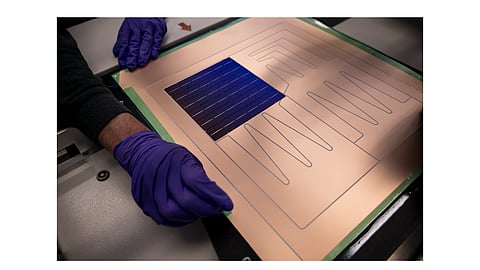

Dutch research center TNO is teaming up with three other companies in Holland—Eurotron, GroenLeven and SIEC—in a project called Whooper that adapts the metal wrap-through technology approach onto the heterojunction (HJT) solar cell platform. The aim of the project is to integrate the high efficiency HJT cell technology and MWT module approach into a new solar module design and make it ready for mass production. The ultimate goal of the Whooper project is the industrial demonstration of the combination of MWT and HJT.
About MWT
MWT is a more than decade old technology that mainly aimed at shifting the current collecting busbars of the cells on to the rear side. The contacts between the front fingers and rear busbars are established by drilling holes – also called vias -, which are filled with conductive metallization pastes. However, the technology has not entered the mainstream yet. The reason? The module technology has seldom changed till the recent past and the concept essentially remained the same, according to Gianluca Coletti from TNO, who is the coordinator of the Whooper project.
At the same time, MWT not only requires a change at cell level, the crux of the approach lies in module making. Here the cells are attached to the conductive foil and the interconnection happens during the lamination process, similar to Meyer Burger's SWCT. However, "The advantage at the cell level is not enough to make the change module technology considerably, especially in those days of MWT Al-BSF," said Coletti. The technology has also been missing a high efficiency cell technology platform. Still, few companies saw the advantage of the technology at module level, and today MWT technology is already in commercial production at about GW scale.
Complementing factors
HJT, which already demonstrated its high efficiency potential exceeding 24% in production, provides an attractive cell level platform for MWT. HJT and MWT are not just compatible, they actually complement each other. MWT supports a low temperature interconnection process which is what is exactly preferred by HJT. The combination is expected to bring about 3% to 5% power gain at the module level. In addition to the power boost, MWT adds stunning aesthetics to a solar module, thus providing several ingredients for a premium product. In fact, TNO's MWT technology platform offers a high degree of flexibility for making different patterns.
Process wise MWT requires drilling the via holes with a laser, which is a well-established process. Though HJT is considered to be a high end technology-oriented process with sensitive layers, drilling holes would not have any impact on cell performance, argued Coletti, adding "The Voc for HJT-MWT cells remained the same 735 mV as that of the reference cells and showed an efficiency gain due to reduced shading".
MWT also helps in reducing silver paste consumption by 50% compared to conventional cell designing. Another advantage of MWT is scalability of the number of holes according to the module design and wafers size, which is not the case with traditional soldering technology. Coletti explains this with an example, scaling from 5 busbars to MBB requires a completely new tool set, while with MWT it is simply increasing the number of vias.
Roles of partners
Coming to the role of the members of the project, TNO will carry out the final optimization and design of the Whooper cell technology, demonstrating cell manufacturing in an industrial pilot line in cooperation with a cell maker. TNO will also be involved in designing and making of mini-modules, as well as responsible for demonstrating their reliability through tests.
Eurtron, a solar module production equipment maker, will be responsible for producing full size modules with a goal to make 90 modules per hour. Dutch solar developer GroenLeven will facilitate the project by installing and operating the monitoring field with Whooper solar panels. The role of SIEC in the project is to provide a representative environment with the SIEC field lab located within the Oranjepoort solar park in the municipality of Emmen, Netherlands.
